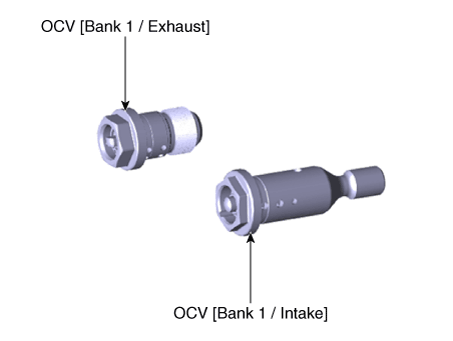Hyundai Elantra: Engine Control System / CVVT Oil Control Valve (OCV)
Hyundai Elantra (CN7) 2021-2025 Service Manual / Engine Control / Fuel System / Engine Control System / CVVT Oil Control Valve (OCV)
Description and operation
| Description |
Continuous Variable Valve Timing (CVVT) system advances or retards the valve timing of the exhaust valve in accordance with the ECM control signal which is calculated by the engine speed and load.
By controlling CVVT, the valve over-lap or under-lap occurs, which makes better fuel economy and reduces exhaust gases (NOx, HC) and improves engine performance through reduction of pumping loss, internal EGR effect, improvement of combustion stability, improvement of volumetric efficiency, and increase of expansion work.
This system consist of the CVVT Oil Control Valve (OCV) which supplies the engine oil to the cam phaser or cuts the engine oil from the cam phaser in accordance with the ECM PWM (Pulse With Modulation) control signal, and the Cam Phaser which varies the cam phase by using the hydraulic force of the engine oil.
The engine oil getting out of the CVVT oil control valve varies the cam phase in the direction (Intake Advance/Exhaust Retard) or opposite direction (Intake Retard/Exhaust Advance) of the engine rotation by rotating the rotor connected with the camshaft inside the cam phaser.

Repair procedures
| Removal and Installation |
| 1. | Remove the CVVT oil control valve. (Refer to Engine Mechanical System - "CVVT & Camshaft") |
| 2. | Install in the reverse order of removal. |
 Purge Control Solenoid Valve (PCSV)
Purge Control Solenoid Valve (PCSV)
Description and operation
DescriptionPurge Control Solenoid Valve (PCSV) is a solenoid valve and is installed on the surge tank and controls the passage between the canister and the intake manifold...
 Variable Force Solenoid (VFS)
Variable Force Solenoid (VFS)
Description and operation
DescriptionCVVT (Continuous Variable Valve Timing) system advances or retards the valve opening and closing timing of the intake or the exhaust valve in accordance with the ECM control, calculated by the engine speed and the load...
Other information:
Hyundai Elantra (CN7) 2021-2025 Service Manual: Console Armrest
Components and components location Component Location [This illustration shows the LHD type. RHD type is symmetrical.]1. Console armrest Repair procedures Replacement • When removing with a flat - tip screwdriver or remover, wrap protective tape around the tools to prevent damage to components...
Hyundai Elantra (CN7) 2021-2025 Service Manual: Fuel Sender Assembly
Repair procedures Removal1.Remove the fuel pump. (Refer to Fuel Delivery System - "Fuel Pump")2.Disconnect the fuel pump motor connector (A) and fuel sender connector (B).3.Release the fixing hook (A) and then remove the fuel sender (B).Installation1...
Copyright © 2025 www.helantra7.com

